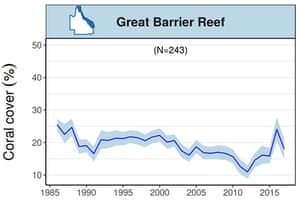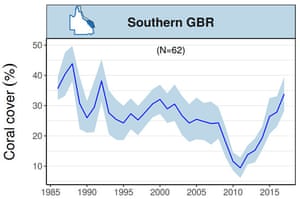Parts of the Great Barrier Reef not regularly affected by problems such as cyclones have demonstrated the reef still has the ability to regenerate, with a survey showing sharp declines in coral cover in the north but increases elsewhere.
However, the latest results from the Australian Institute of Marine Science (Aims), collected by divers visiting 243 individual reefs, do not include the losses caused by bleaching this year, or the effects of cyclone Debbie, both of which killed coral in the central section.
Up until March 2017, the results show that coral cover over the whole Great Barrier Reef improved dramatically between 2012 and 2016 but then suffered an unprecedented loss from the 2016 bleaching, with about a quarter of the reef’s coral being killed.
The head of the long-term monitoring program at Aims, Hugh Sweatman, said the capacity of the reef to recover was under threat from climate change, as well as other chronic stressors such as pollution.
“The predictions under climate change are that cyclones will get more intense, which means there will be more damage, so they will require longer to recover,” Sweatman said. In addition, pollution and warmer waters are slowing the rate of recovery.
“So you’ve got this double whammy. The time for recovery is likely to get less and the rate of recovery is going to be impeded.
“So what I’m saying is it’s OK so far but there are limits to this.”
Sweatman also noted the recovery in the southern section of the Great Barrier Reef was partly a result of those reefs being mostly dominated by fast-growing corals, which are easily damaged by cyclones but recover relatively quickly.
Richard Leck, a campaigner at WWF, said the results gave hope to conservationists.
“There is still resilience in the system,” Leck said. “This data shows that if the reefs aren’t exposed to underwater heatwaves, if they’re not subject to major pollution events, and they’re not hit by a cyclone, then they recover really well and that should give us a lot of hope that the resilience of the Great Barrier Reef is still there and, if we reduce those threats, we should see recovery reef-wide.”

Trends in mean hard coral cover for the whole Great Barrier Reef up
until March 2017, from the Australian Institute of Marine Science’s
long-term monitoring program. N indicates the number of reefs
contributing to the analyses; blue shading represents 95% certainty.
Photograph: Australian Institute of Marine Science
As a result, the northern Great Barrier Reef has lost the majority of its coral, declining from about 25% coral cover in 2010 to just 10%. “This level of decline is unprecedented in the 30+ year time series,” the report said.

Trends in mean hard coral cover for the central Great Barrier Reef up
until March 2017, from the Australian Institute of Marine Science’s
long-term monitoring program. N indicates the number of reefs
contributing to the analyses; blue shading represents 95% certainty.
Photograph: Australian Institute of Marine Science
Sweatman said next year’s results will likely reveal even more significant coral loss in that region, following the most recent bleaching and cyclone Debbie.
In the southern section of the Great Barrier Reef, the latest results show continued improvement in coral cover. In that region, coral cover had reduced from almost 45% coverage in the mid-1980s, to below 10% in 2011. The latest results show coral cover has continued to recover, to more than 30%.

Trends in mean hard coral cover for the Southern Great Barrier Reef up
until March 2017, from the Australian Institute of Marine Science’s Long
Term Monitoring Program. N indicates the number of reefs contributing
to the analyses; blue shading represents 95% certainty. Photograph:
Australian Institute of Marine Science
Imogen Zethoven, from the Australian Marine Conservation Society, said it was “heartening to see coral cover increase significantly in the southern third of the Great Barrier Reef”.
“It’s not too late to save our reef but the federal government must stop the Adani coalmine, reject all new coalmines and switch to 100% renewable energy as a matter of urgency,” Zethoven said.
Sumber : TheGuardian
No comments:
Post a Comment